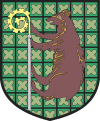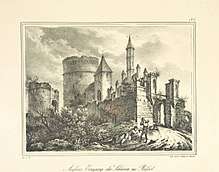Reszel
Reszel [ˈrɛʂɛl] (![]()
Reszel | |
|---|---|
    
| |
 Flag  Coat of arms | |
 Reszel  Reszel | |
| Coordinates: 54°3′5″N 21°8′45″E | |
| Country | |
| Voivodeship | |
| County | Kętrzyn |
| Gmina | Reszel |
| Area | |
| • Total | 3.82 km2 (1.47 sq mi) |
| Population (2012) | |
| • Total | 4,896 |
| • Density | 1,300/km2 (3,300/sq mi) |
| Postal code | 11-440 |
| Website | http://www.reszel.pl/ |
History

Reszel was originally a settlement built by the Bartian tribe of Old Prussians and conquered by the Teutonic Knights in 1241.[3] The native Prussians later recaptured the settlement and held it for five years, but were eventually defeated by the German crusaders. Reszel received its town privileges in 1336 under Magdeburg law.
Upon the request of the Prussian Confederation, Polish King Casimir IV Jagiellon signed the act of incorporation of the region along with Reszel to Poland, an event that sparked the Thirteen Years' War. In 1455 the Teutonic Knights captured the town and later on, in 1462, ceded their power to the Warmian bishop, who once more in 1464 recognized the Polish King as the rightful ruler of Warmia with Reszel. The incorporation of Reszel to the Kingdom of Poland was confirmed in a peace treaty signed in Toruń in 1466.[4] In the 17th century, the Jesuits came to Reszel and established a college in 1632 and the Polish King John II Casimir Vasa created a scholarship fund for its students.
In 1772 Reszel became part of the Prussian Partition of Poland.
In 1811 Barbara Zdunk was sentenced by the Prussian court to death for witchcraft and setting the castle alight in 1807.[5][6] The trial is sometimes described as the last burning of witches in Europe.[6][7][8]
As a result of the treaty of Versailles on 11 July 1920 the 1920 East Prussian plebiscite was organized under the control of the League of nations, which resulted in 3,260 votes to remain in Germany and none for Poland.[9][10]
Following the Potsdam Conference of 1945, just after the Second World War, the town was transferred from Germany to Poland for administration, as of half of East Prussia.[11]
Tourist attractions
The main tourist attraction is the Gothic Episcopal castle. It was built 1350−1401 on a steep hill side above the right bank of the river Sajna by the Teutonic Order.
The Gothic St Peter's Church dating back to the 14th century boasts the painting of the church's patron dating back to the end of the 18th century. Other worthy of note buildings are the Jesuit complex, St John's Church and the church and convent of the nuns of the Order of St Catherine − all from the 15th and the 16th century. Large fragments of preserved defensive walls and the Classicist town hall in the market square dating back to the 19th century are also worth visiting.
Near Reszel is the Catholic shrine of Święta Lipka (German: Heiligelinde), a baroque church and Late Medieval shrine augmented in the 17th century. Since its beginning it has attracted German pilgrims from Warmia, as well as Polish and Lithuanian pilgrims.
Notable residents
- Jodocus Willich (1501–1552), physician
- Barbara Zdunk (1769–1811), arsonist and witch
- Andreas Thiel (1826–1908), Bishop of Warmia (1885-1908)
- Julius Dinder (1830–1890), Archbishop of Gniezno and Poznań
- Karol Zalewski (born 1993), Polish athlete
Images
 Historic city center
Historic city center- Tenements, part of the gothic city center
- Town Hall
- Market Square
 Wyspiańskiego Street
Wyspiańskiego Street.jpg) Former Jesuit College
Former Jesuit College
See also
- Rema S. A. headquarters
References
- "Castle in Reszel". Retrieved 2 April 2017.
- "Reszel - Cittaslow International". Retrieved 2 April 2017.
- "Reszel Castle, Gmina Reszel, Poland - SpottingHistory.com". Retrieved 2 April 2017.
- "Local history - Information about the town - Reszel - Virtual Shtetl". Retrieved 2 April 2017.
- "Burning of the Last Witch in Europe in Reszel". Retrieved 2 April 2017.
- "Reszel (The Town) - Further Afield - Warsaw". Retrieved 2 April 2017.
- says, Crystal Harvey (21 August 2015). "1811: Barbara Zdunk, the last witch (sort of)". Retrieved 2 April 2017.
- Fakt.pl (15 March 2016). "Spłonęła na stosie, ale wciąż jest groźna!". Retrieved 2 April 2017.
- Marzian, Herbert; Kenez, Csaba (1970). Selbstbestimmung für Ostdeutschland – Eine Dokumentation zum 50 Jahrestag der ost- und westpreussischen Volksabstimmung am 11. Juli 1920 (in German). p. 115.
- "Historia miejscowości - Informacje o mieście - Reszel - Wirtualny Sztetl". Retrieved 2 April 2017.
- "Historia". Retrieved 2 April 2017.
External links
| Wikimedia Commons has media related to Reszel. |
- Municipal website (in Polish)
- Site of Reszel (in Polish)
- Site of Reszel (in English)
- Statistics of inhabitants, birth, marriage, deaths, from 1569